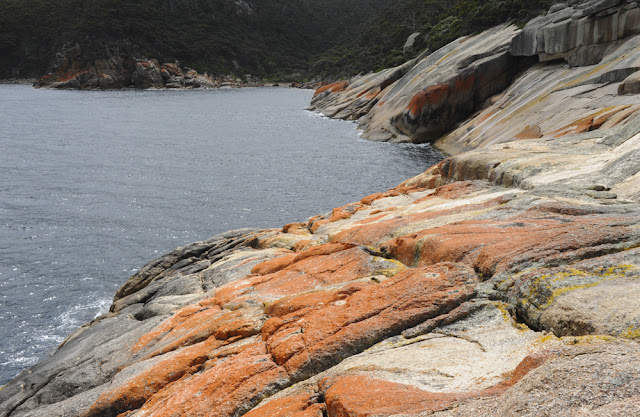Maria Island
This is the first of three posts, an overview, on a recent trip to Maria Island off the east coast of Tasmania. The island is a national treasure, for history as well as wildlife and it is managed by the Parks and Wildlife Service, Tasmania. As it is an island, it has to be accessed by boat and there is no vehicle service, so all is quiet on the island. And I never tried to seek a signal for my mobile either. Peace.
Our perfect landing spot on the beach of Chinaman's Bay on the west coast of an isthmus between the two main landmasses at the north and south of the island. At the longest, the island is about 20 km, and at the widest, about 13 km.
Trails of Pink Pigface Carpobrotus rossii spread down a sand dune on the east side of the isthmus on Ocean Beach, where there is usually a swell coming in from the Pacific.
Granite rocks present a rough headland at the southern tip of the island, the clean rock indicating how high the sea hammers on the cliffs in storms.
Orange lichen grows on the coastal granite just above the water splash zone. These are Hymeneliaceae sp. and are characteristic of coastal granite in southern Australia. This cove is Haunted Bay, sheltered from the westerlies and once used by whalers to lie up while processing blubber from whales and seals killed in the surrounding sea.
Mount Maria (711 m), the highest point on the island is in the northern part. This and the other high peaks, Bishop and Clerk, are of dolerite and all the high ground is swathed with continuous eucalyptus forest.
There are a few wetlands, pools and marshes on the coastal plains on the west of the northern part of the island. The most abundant birds I saw there were white-faced herons and black swans.
The eastern side of the island drops off in cliffs, their abrupt edge contrasting with the gentle slopes on the west. The whole island would have been covered with forest as in the background of this photograph, the grassland is a remnant from the days of european settlement and agricultural clearing.
The east coast of the northern part of the island does not present such a perfect landing spot.









No comments:
Post a Comment